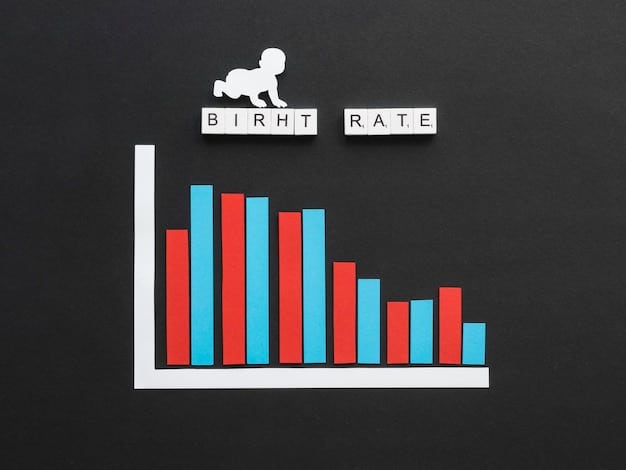Understanding Social Security Changes: The 2.8% COLA Impact

Understanding the recent changes to Social Security benefits, particularly the 2.8% Cost of Living Adjustment (COLA) increase, is crucial for retirees and those planning for retirement to accurately project their income and financial security.
Navigating the complexities of Social Security can often feel overwhelming, especially when new adjustments are introduced. Let’s delve into understanding the recent changes to Social Security benefits: What the 2.8% COLA Increase Means for You.
What is the Social Security Cost of Living Adjustment (COLA)?
The Social Security Cost of Living Adjustment, commonly known as COLA, is an annual adjustment to Social Security and Supplemental Security Income (SSI) benefits. It’s designed to ensure that the purchasing power of these benefits isn’t eroded by inflation.
Each year, the Social Security Administration (SSA) determines the COLA based on changes in the Consumer Price Index for Urban Wage Earners and Clerical Workers (CPI-W). This index reflects the average change over time in the prices paid by urban consumers for a “basket” of consumer goods and services.
How is COLA Calculated?
The calculation of COLA involves comparing the average CPI-W for the third quarter (July, August, and September) of the current year with the average for the same quarter of the last year in which a COLA was determined. The percentage increase between these two averages, if any, becomes the COLA for the following year.
For instance, if the CPI-W average for the third quarter of 2023 was higher than that of 2022, a COLA would be applied to Social Security benefits in 2024. This calculation ensures that benefits keep pace with rising prices, helping beneficiaries maintain their standard of living.
Why is COLA Important?
COLA is crucial because it provides a safeguard against inflation. Without it, the real value of Social Security benefits would decline as prices for everyday goods and services increase. This would disproportionately affect retirees and individuals with disabilities who rely on these benefits as a primary source of income.
- Ensures benefits keep pace with inflation.
- Protects the purchasing power of Social Security.
- Supports the financial stability of beneficiaries.
- Helps maintain the standard of living.
In summary, the Social Security Cost of Living Adjustment (COLA) is a mechanism designed to protect the real value of Social Security benefits by adjusting them annually to reflect changes in the cost of living, as measured by the CPI-W.
Understanding the 2.8% COLA Increase for Social Security
For 2024, Social Security recipients saw a 2.8% increase in their benefits. While this might seem like a modest increase, it’s important to understand how this adjustment affects your individual benefits and overall financial planning.
The 2.8% COLA increase was determined based on the rise in the CPI-W from the third quarter of 2022 to the third quarter of 2023. This increase is then applied to each beneficiary’s monthly Social Security payment.

How Does the 2.8% Increase Translate to Real Dollars?
The actual dollar amount of the increase varies depending on the individual’s benefit amount. For example, if your monthly Social Security benefit was $1,500 in 2023, a 2.8% increase would add $42 to your monthly payment, bringing it to $1,542 in 2024.
It’s important to note that this increase is before any deductions, such as those for Medicare premiums. The net increase in your Social Security check may be lower depending on these deductions.
Impact on Different Beneficiaries
The 2.8% COLA increase impacts different beneficiaries in varying ways:
- Retirees: The increase helps retirees maintain their purchasing power, allowing them to better afford essential goods and services.
- Disabled Individuals: For those receiving Social Security Disability Insurance (SSDI), the COLA increase aids in covering medical expenses and other living costs.
- Survivors: Survivors receiving benefits also see an increase, providing additional financial support.
Understanding how the 2.8% COLA increase translates into real dollars for different beneficiaries can provide clarity on its impact and importance of understanding the recent changes to Social Security benefits: What the 2.8% COLA Increase Means for You.

Historical Perspective: Social Security COLA Rates Over Time
To fully appreciate the significance of the 2.8% COLA increase, it’s helpful to look at historical COLA rates and understand how they have varied over time. This historical perspective provides context and helps in assessing the current adjustment.
COLA rates have fluctuated significantly from year to year, largely depending on the prevailing economic conditions and inflation rates. In some years, there have been no COLA increases at all, while in others, the increases have been substantial.
Notable COLA Rates in Recent History
Here are some notable COLA rates from recent history:
- 2009: 5.8%
- 2012: 3.6%
- 2016: 0.0%
- 2019: 2.8%
- 2022: 5.9%
- 2023: 8.7%
Factors Influencing COLA Rates
Several factors influence COLA rates, including:
- Inflation: Higher inflation rates generally lead to higher COLA increases.
- Economic Growth: Strong economic growth can sometimes moderate inflation, leading to lower COLA rates.
- Government Policies: Government decisions on fiscal and monetary policy can influence inflation and, consequently, COLA rates.
Implications of Varying COLA Rates
The implications of varying COLA rates are significant for Social Security beneficiaries. In years with low or no COLA increases, the purchasing power of benefits can erode, making it harder for beneficiaries to afford essential goods and services. Conversely, higher COLA increases can provide a much-needed boost to beneficiaries’ income, helping them keep pace with rising prices.
COLA rates have varied significantly over time, influenced by inflation, economic growth, and government policies. It’s essential to monitor these fluctuations to understand their impact on Social Security benefits.
How the 2.8% COLA Increase Affects Your Social Security Benefits
The 2.8% COLA increase for Social Security benefits has specific implications for different aspects of the program. Let’s look at how it affects retirement benefits, disability benefits, and the maximum earnings subject to Social Security tax.
Understanding these changes can help you plan your finances and make informed decisions about your retirement and financial future.
Impact on Retirement Benefits
For retirees, the 2.8% COLA increase means an additional 2.8% on their monthly benefit amount. As illustrated earlier, if a retiree’s benefit was $1,500 per month in 2023, they would receive $1,542 in 2024.
This increase helps retirees maintain their standard of living and better cope with rising costs but it’s important to understand understanding the recent changes to Social Security benefits: What the 2.8% COLA Increase Means for You.
Effects on Disability Benefits
Individuals receiving Social Security Disability Insurance (SSDI) also benefit from the 2.8% COLA increase. This increase can help disabled individuals afford essential medical care, housing, and other living expenses.
The additional income can provide a much-needed financial cushion for those with disabilities who often face higher healthcare costs and limited employment opportunities.
- Retirement benefits increase by 2.8%.
- Disability benefits also increase by 2.8%.
- The impact varies depending on individual circumstances.
The 2.8% COLA increase affects retirement benefits, disability benefits, and other aspects of Social Security, providing additional financial support to beneficiaries.
Strategies for Maximizing Your Social Security Benefits
While understanding COLA increases is important, it’s equally crucial to know how to maximize your Social Security benefits. There are several strategies you can employ to ensure you receive the highest possible benefit amount.
These strategies involve careful planning and decision-making throughout your working life and leading up to retirement.
Delaying Retirement
One of the most effective strategies for maximizing your Social Security benefits is to delay retirement. For each year you delay claiming benefits past your full retirement age (up to age 70), your benefit amount increases by a certain percentage.
This delayed retirement credit can significantly boost your monthly benefit amount, providing you with more income during your retirement years.
Working Longer
Working longer can also increase your Social Security benefits. The Social Security Administration calculates your benefit based on your 35 highest earning years. By working longer, you can replace lower-earning years with higher-earning years, boosting your overall benefit amount.
Coordinating with Your Spouse
Married couples have additional options for maximizing their Social Security benefits. One strategy is to coordinate claiming strategies to ensure that each spouse receives the highest possible benefit amount.
- Delay retirement for higher benefits.
- Work longer to replace low-earning years.
- Coordinate strategies with your spouse.
- Consider the impact of taxes on benefits.
By employing strategies such as delaying retirement, working longer, and coordinating with your spouse, you can maximize your Social Security benefits and ensure a more secure retirement.
The Future of Social Security and COLA Adjustments
Looking ahead, the future of Social Security and COLA adjustments is a topic of ongoing discussion and concern. Several factors could influence the sustainability and adequacy of these benefits in the years to come.
Understanding these factors and potential changes can help you prepare for your financial future and make informed decisions about your retirement planning.
Demographic Trends
Demographic trends, such as the aging of the baby boomer generation and declining birth rates, pose challenges to the Social Security system. As more people retire and fewer people enter the workforce, the system faces increased strain.
This demographic shift could lead to adjustments in benefit levels, retirement ages, or tax rates to ensure the system’s long-term solvency.
Economic Factors
Economic factors, such as inflation, wage growth, and interest rates, also play a significant role in the future of Social Security and COLA adjustments. Higher inflation rates could lead to larger COLA increases, while slow wage growth could strain the system’s funding.
Policy Considerations
Policy considerations, such as potential reforms to the Social Security system, could also impact future COLA adjustments. These reforms could include changes to the way COLA is calculated or adjustments to benefit formulas.
- Demographic trends impact system solvency.
- Economic factors influence COLA adjustments.
- Government policies can lead to reforms.
Demographic trends, economic factors, and policy considerations all play a role in the future of Social Security and COLA adjustments, highlighting the importance of ongoing monitoring and planning.
| Key Point | Brief Description |
|---|---|
| 💰 2.8% COLA Increase | Benefits increased by 2.8% in 2024 due to inflation. |
| 📈 Historical COLA | COLA rates vary yearly based on economic conditions. |
| ⏳ Delaying Retirement | Delaying retirement can maximize Social Security benefits. |
| 👪 Spousal Benefits | Coordinate with your spouse to maximize combined benefits. |
Retractable FAQ Section
Frequently Asked Questions
▼
COLA, or Cost of Living Adjustment, is an annual increase to Social Security benefits designed to counteract the effects of inflation. It ensures that retirees’ and other beneficiaries’ purchasing power isn’t diminished over time.
▼
The COLA is primarily based on the Consumer Price Index for Urban Wage Earners and Clerical Workers (CPI-W). The average CPI-W for the third quarter of the current year is compared to the previous year.
▼
If you receive Social Security benefits, your monthly payment will increase by 2.8% starting in January of the following year. The exact dollar amount will depend on your current benefit level.
▼
Yes, delaying your retirement can significantly increase your Social Security benefits. For each year you delay collecting benefits after full retirement age, the monthly payment amount increases.
▼
Future concerns about Social Security include demographic trends, such as an aging population and declining birth rates. Potential policy changes could affect retirees’ financial security.
Conclusion
In summary, understanding the recent changes to Social Security benefits: What the 2.8% COLA Increase Means for You, is essential for both current and future beneficiaries. By staying informed about these adjustments and planning accordingly, you can make well-informed decisions to secure your financial future. It’s also important to monitor ongoing discussions about the long-term sustainability of Social Security, as future policy changes might affect your retirement income.





